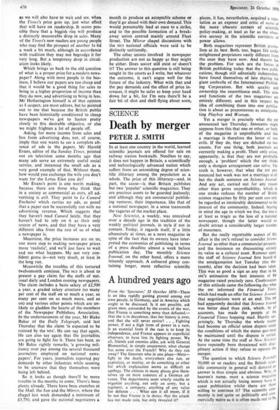SCIENCE
Death by merger
PETER J. SMITH
In at least one country in the world, learned scientific journals are offered for sale on railway station bookstalls. Needless to say, it does not happen in Britain, a scientifically and technologically advanced nation which suffers from an astonishing degree of scien- tific illiteracy among the population as a whole. The price of this illiteracy—and, in part, the cause—is that Britain publishes but two 'popular' scientific magazines. They are precious assets to be guarded jealously; and although they are commercial publish- ing ventures, their importance, like that of a national newspaper, in a sense transcends the vagaries of the market place.
New Scientist, a weekly, was conceived over a decade ago in the tradition of the weekly political journals, in style if not in content. Today, it regards itself, if a little obsessively at times, as a news magazine in spite of the fact that its owners have inter- preted the economics of publishing in terms of a press deadline almost a week before publication day. The monthly Science Journal, on the other hand, offers a more leisurely approach. A coloured glossy con- taining longer, more reflective scientific
pieces, it has, nevertheless, acquired a repu. tation as an exposer and critic of some of the more obscure corners of scientific policy-making, at least as far as the obses. sive secrecy in the scientific corridors of power allows.
Both magazines represent British journa- lism at its best. Both, too, began life under enlightened proprietors vastly different from the ones they have now. And therein lies the problem. For such are the forces in British publishing today that the two publi-
cations, though still editorially independent, have found themselves of late sharing the giant umbrella of the International Publish.
ing Corporation. But with quality and ownership the resemblance ends. The aims and functions of the two magazines are entirely different; and in this respect the idea of combining them into one publics. tion is about as preposterous as amalgama. ting Playboy and Woman.
Yet a merger is precisely what the IPC announced last Thursday. Innocents might
suppose from this that one or other, or both, of the magazine is unprofitable and that a marriage is therefore the lesser of two evils. If they do, they are deluded on two
counts. For one thing, both journals are currently making a profit. Their only crime, apparently, is that they are not profitable enough, a 'problem' which the IPC thinks only a shotgun arrangement can solve. The truth is, however, that what the IPC pro- nounced last week was not a marriage at all but the death sentence on Science Journal. And any act, carried out for any reason other than gross unprofitability, which in one stroke reduces the number of British science magazines by fifty per cent can only be regarded as intolerably detrimental to the interest of the community. Indeed, bearing in mind the age in which we live, the loss is at least as tragic as the loss of a national newspaper, though the latter would no doubt attract a considerably larger number of mourners.
But the really regrettable aspect of this affair is the am's refusal to consider Science Journal as other than a commercial property, and the insistence on discounting entirely its value as a cultural asset. Rumour apart, the staff of Science Journal first heard of the amalgamation last Tuesday (the thir- teenth), after the decision had been taken. This was as good a sign as any that in the• IPC'S estimation the best interests of the magazine rated precisely zero. Confirmation of this attitude came the following day when the IPC informed the Financial Times, which had made an offer for Science Journal, that negotiations were at an end. The iPC had apparently decided that Science Journal was better dead than pink, which, by all accounts, has made the people at the Financial Times hopping mad. Hardly sur- prisingly, by Thursday the whole matter had become an official union dispute under the conditions of which the status quo must be maintained until the dispute is settled. At the same time the staff at New Scientist have reputedly been threatened with disci- plinary action if they refuse to operate the merger. The question to which Science Journal's 50,000 or so readers and the British scien- tific community in general will demand an answer is thus simple and obvious. Why. in heaven's name, must a science magazine which is not actually losing money have to cease publication whilst there are those willing to continue it? The scientific com- munity is not quite so politically and com- mercially naive as it is often made out to be:














































 Previous page
Previous page